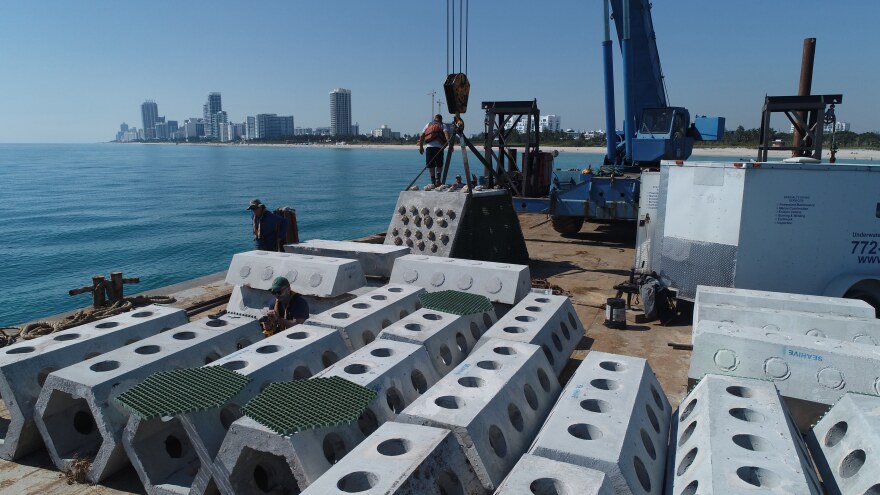A new manmade hybrid reef being tested off Miami Beach aims to do what climate change has increasingly foiled: provide a powerful protector to storm surge and rising seas hammering Florida’s shores.
If successful, the University of Miami Rosenstiel-designed reef could become part of a larger U.S. Department of Defense project to better armor parts of the state.
“This is to see if we can do it, if we can do it better than alternatives, and if we can do it better for the same price,” said Andrew Baker, a coral biologist and member of the UM team overseeing the project with Miami Beach. “An important part of this is [that] we can't come up with an incredibly expensive solution that is going to protect a small area of coastline at great cost. This has to be scalable.”
Artificial reefs are nothing new in Florida. Boats, barges, concrete, even tires and statues have been sunk to provide habitat for fish, draw divers and provide wave breaks. The Florida Fish and Wildlife Conservation Commission has tracked more than 3,900 statewide.
But this project has a loftier goal: to both protect the coast and create a thriving, self-sustaining reef populated with coral capable of surviving a warming planet and where natural reefs are disappearing.
“It's very easy to create structure. You can just dump a bunch of rocks on the bottom,” said UM coastal ecologist Diego Lirman, whose lab started one of the state’s first coral nurseries in 2007 and will be supplying specially bred coral. “The challenges to make these structures also function and look like a coral reef.”
Roots of hybrid reef project
The project got underway before the pandemic in 2018, when Miami Beach agreed to let scientists sink the hybrid reef offshore, just beyond buoys marking the swim zone. Engineers began working on designs, eventually settling on a hollowed out trapezoid, often used for coastal barriers, and a new honeycomb-shaped structure they dubbed SeaHives.
Smaller versions of the structures were tested in UM’s hurricane tank which can replicate waves and winds powered by a Category 5 storm.
The structures’ ability to absorb wave strength was measured and then remeasured by adding limestone boulders, to replicate bumpy reefs, along with actual coral.
“We showed very clearly that the structure itself can mitigate the majority of the wave height and energy. More than 60% are basically taken care of by just having structure shallow and close to shore,” Lirman said. “But then when we started adding coral.”
The coral knocked off another 15 to 20 percent of the wave’s energy, he said.
Eventually they settled on the two structures, standing about six feet tall and a little larger than a minivan.
With the designs settled, researchers then began investigating coral. Because the hybrid reef will be closer to shore in shallower water than coral on Florida’s fringe reef, the transplanted corals will need to be able to withstand more light and rougher waves. They also need to grow fast.
That led to an obvious choice: branching, fast-growing elkhorn and staghorn, traditional wave-breakers that once blanketed much of Florida’s reef tract but got wiped out by disease and bleaching events. In 2021, a UM study found that staghorn in particular can double the reef’s ability to shred waves.
The team also plans to use reef building coral, like brain and mounding coral. And to keep the reef healthy, they’ll add sea urchins and other grazers that eat algae and tidy up.

“Artificial reefs have been around for a long time so we want to avoid sort of repeating some of the mistakes of the past. We don't want these structures to become covered in algae and seaweeds and sort of become an eyesore,” Baker said. “We want them to be a living, thriving ecosystem, and that's challenging.”
The pandemic stalled work, which they’d hoped to begin in about 2021, Baker said. But with the units now deployed, they hope to speed up work. Within hours of being submerged last week, the structures began attracting fish.
Will hybrid reef survive?
In six months, once the structures have settled, divers will begin attaching the coral. In about two years, Baker said, they’ll know if the coral are likely to survive along with monitoring data to determine the success of weakening waves.
If successful, it could be a powerful barrier to storm surge expected to grow worse as climate change fuels more intense hurricanes. A 2019 study by the U.S. Geological Survey found reefs in South Florida alone can cut damages during storms between about $650 million and $1.6 billion.
Eventually, they could become part of a U.S. Department of Defense project to armor parts of Florida’s coast.
Last year, Baker's lab was awarded $7.5 million to develop protective reefs. Intitial plans call for more than two football field-length tracts around the state. For that project, Baker said the coral will also need to be tested to determine that amount of ocean heat they can tolerate.
“It's very much tied to these kinds of climate projections and trying to figure out, do we have enough resistance and can we engineer enough resistance in enough time, and what are the limitations of that and what are the trade offs?” he said.
In the meantime, Miami Beach gets the potential benefit of a powerful barrier, he said, “that will actually help protect coastlines, help reduce people's potential insurance bills and prevent coastal flooding and beach erosion and all the other things that the kind of plague us on an everyday basis, but also on a periodic basis through these really big storms that we sometimes get.”






